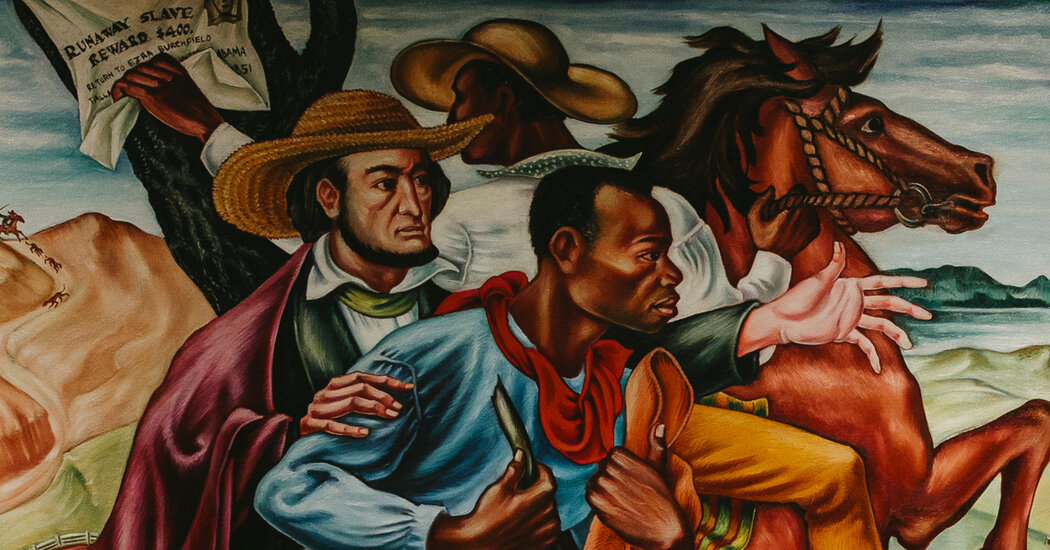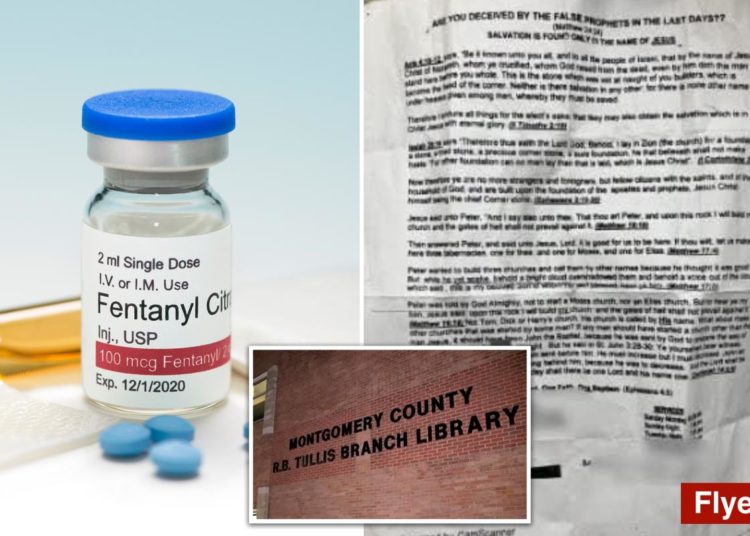In May 2024, soon after Rica Lewis-Payton became board chair of Talladega College, a historically Black institution in rural Alabama, she faced a crisis. The college, which has a paltry endowment of under $5 million, couldn’t meet its payroll that month. “We had to look at every asset that we have,” Lewis-Payton, a retired hospital executive and 1981 Talladega alumna, said in an interview.
Talladega’s outstanding asset was a group of six remarkable murals that the Black artist Hale Woodruff painted there between 1939 and 1942, commemorating interracial cooperation in the African American struggle for freedom and advancement. One, a swirling tableau of men overwhelming their captors on a slave ship, titled “The Mutiny on the Amistad,” is the artist’s most dramatic painting. Another is an emotionally powerful depiction of the Underground Railroad, with allies of both races ushering enslaved people to liberty. In all, “they are Woodruff’s crowning achievement, and among the best American murals,” the art historian Barbara Haskell, a longtime Whitney Museum curator, said in an interview.
Over the last year, Lewis-Payton oversaw a sale in which Talladega will relinquish ownership of four of the six Woodruff murals to the Toledo Museum of Art and two art foundations, in return for an undisclosed sum that art experts estimate at $20 million. “It required deliberate thought and execution,” Lewis-Payton said. “I sit here today feeling good that we are leveraging this most prized possession in a way that will improve the ability of the college to provide a foundational education for people like me.”
Lewis-Payton said she understood that the sale of these paintings would surrender a key piece of Talladega’s legacy and potentially provoke vehement opposition. Yet the college administrators realized the works were going mostly unseen. In 2012, the murals were removed for conservation and then sent off on a four-year, eight-city tour, in what Roberta Smith, writing in The New York Times, called a “stunning exhibition.” Despite that exposure, once they returned to Talladega to be installed in a new museum building, only 500 people came to view them annually.
“It’s like your grandmother’s quilt,” Willie Todd, the college president, said. “It’s a beautiful quilt and everyone loves it, but it’s in the attic.”
Woodruff’s three murals that portray the 1839 uprising by 53 enslaved Africans aboard the Spanish schooner La Amistad, and its aftermath, are being jointly acquired by the Art Bridges Foundation and the Terra Foundation for American Art, two nonprofit organizations that lend American art to public institutions.
The Toledo Museum of Art is buying Woodruff’s later depiction of the Underground Railroad. Two other murals, which illustrate events in the history of Talladega College, will remain at the school.
While the agreement is not yet formalized, executives at the Toledo Museum and the art foundations said they would highlight in perpetuity the murals’ connection to Talladega in wall text whenever the works are lent. They also stipulate that the murals will be reunited at the college, likely every six to eight years. (Some potential buyers who did not agree to these terms were disqualified.)
“This is going to expand the branding of our institution, and they will witness the beauty of this artwork around the world,” said Todd, who became college president in July, when the de-accession was already underway.
Lewis-Payton said that “increasing the visibility of these incredible pieces of art was a guiding principle from the very beginning.” She added, “The story isn’t being told.”
The murals take on a powerful resonance when seen on the campus for which they were made. In 1867, Talladega College (briefly called Swayne School) was founded by two formerly enslaved men with the support of the racially integrated American Missionary Association, a Congregationalist organization that grew out of a committee that defended the Amistad mutineers and promoted the education of African Americans.
When Woodruff agreed in 1938 to depict the Amistad saga, the episode was so widely forgotten that he had never heard of it. At the time, he was directing the art department at Atlanta University, another H.B.C.U., after reluctantly returning to the United States from Paris to take the secure teaching job at the height of the Depression. In 1937, he spent six weeks working with Diego Rivera in Mexico, where he learned some techniques and was inspired by the social activism of the great Mexican artist. However, Woodruff’s Talladega murals stylistically are closer to the rhythmic, vividly colored works of the American regionalist Thomas Hart Benton.
Woodruff thoroughly researched the history of the Amistad in archives before beginning his murals, although he compressed and invented (such as adding his own likeness among the defendants in a courtroom) when he rendered the gripping tale.
On board the Spanish schooner, a group of Mende people who had been enslaved in Sierra Leone took control off the coast of Cuba, killing the captain and the cook. In Woodruff’s opening tableau, bare-chested men overwhelm their captors. Later, the ship made land in Connecticut, and after trials that reached the Supreme Court, the Africans were freed and returned to their homeland. In huge murals — the courtroom scene is 20 feet long — Woodruff sequentially portrayed the uprising, trial and repatriation.
Three years later, to mark the 75th anniversary of the college’s founding, Woodruff completed a second series, including the mural memorializing the Underground Railroad, and two others. One shows the opening day of Talladega College, with Black men carrying livestock and crops to white administrators to pay for their tuition. The final mural centers on an event seven decades later: the construction by a racially mixed crew of Savery Library, where all the paintings were originally installed.
Contemplating how the murals could be removed from their environment, Lewis-Payton sought guidance. “I knew nothing about the art world,” she said. She turned to James D. Thornton, a former chair of the Talladega board who is currently chair of the Baltimore Museum of Art. Thornton introduced her to an art consultant, Nina del Rio.
Lewis-Payton and del Rio said they initially considered selling all six murals as a unit to a public institution, but determined that potential buyers might be unable to display so many. They came up with a partnership concept: The Amistad murals would be presented for sale as a three-part work. The Underground Railroad painting would be sold separately. And the two that are set at the college would stay there.
On everyone’s mind was an art sale by a historically Black institution that did not proceed smoothly: In 2005, Fisk University in Nashville announced a planned sale to the Crystal Bridges Museum in Bentonville, Ark., founded by the Walmart heir Alice Walton, of the two most valuable works in Fisk’s Alfred Stieglitz Collection, which had been donated by Stieglitz’s widow, the artist Georgia O’Keeffe. The Georgia O’Keeffe Museum sued to block the sale. After a seven-year legal fight, the case was settled. Fisk received $30 million, and in return the two institutions agreed to share ownership of the collection, rotating it every two years. Talladega and the prospective buyers hoped to avoid such public acrimony.
Del Rio approached the Art Bridges Foundation, which Walton founded in 2017 to lend American art to what are now 320 museum partners across the country.
“Immediately I was intrigued, because they are so beautiful,” said Anne Kraybill, chief executive of Art Bridges. “But I was also given pause. They’re so big, and thinking about placement, who would be able to take them?” Consulting some of her partners, she gauged that interest was keen. “To have the greatest reach, we thought we could partner with Terra, which is more global.”
When Turry M. Flucker, vice president of collections and partnerships at the Terra Foundation, received a call from del Rio, he said it felt like “divine intervention,” because he had been studying Woodruff’s Talladega murals for about 30 years. A graduate of Tougaloo College, an H.B.C.U. in Mississippi, he later directed its art museum before coming to Terra. He said he was struck by the inclusiveness Woodruff captured in the paintings.
“These institutions were predominantly African American institutions with African American students, but they were integrated in the sense that they were open to everyone,” he said. “And their founders were an integrated group of people who thought they could push and shake what America looked like.”
Adam Levine, president of the Toledo Museum of Art, felt a similar connection to Woodruff’s mural of the Underground Railroad: Ohio was a stop on the route, and on the side of a clapboard building, Woodruff painted a sign: “State Line — Ohio — .5 Mi.”
“This is an incredible painting that will be deeply meaningful for our audience,” Levine said. “My objective and the objective of the Toledo Museum of Art is to support Talladega College.”
Although a cutback in expenses and a $15 million credit union loan have helped stabilize Talladega’s finances, the underlying strains remain. The college depends heavily on tuition fees, and enrollment has plummeted, from 1,291 in fall 2020 to 745 today. With the sale, “We can become a leader in the reimagining of liberal arts education,” Todd said. “I want every student to graduate with an internship or apprenticeship opportunity. And I want all of our programs to be connected to industry standards and accredited by national accreditors. That takes money.”
Recently, there has been an influx of large donations to H.B.C.U.s. In September, MacKenzie Scott, the philanthropist, gave $70 million to the U.N.C.F. (the United Negro College Fund), which, when combined with $100 million from the Lilly Endowment Inc., will be distributed to 37 constituent H.B.C.U.s for their endowments. (Talladega will get a $5 million infusion.) Michael Lomax, president and chief executive of the fund and a former teacher at Morehouse and Spelman Colleges — both H.B.C.U.s — said he hopes each college will be able to match that amount to total $10 million in fixed endowments.
When Lomax first heard that Talladega might be considering the sale of the Woodruff murals, he was aghast. “It’s not my place to tell an institution what to do, but that would be like giving up part of their soul,” he said. “I would consider the Talladega murals to be a big part of their birthright. Those paintings will not have the same meaning if they’re put in a high-design building and a place that has nothing to do with the paintings.”
But on reflection, and after consultation with Lewis-Payton, he softened his tone. “What is the theme of the Amistad murals?” he said. “It is freedom. And this is allowing them to have financial freedom.” He added, “It was a hard call, but they made the right call. They saved the institution.”
The post To Avert Crisis, Talladega College Sells Its Art Treasures appeared first on New York Times.




